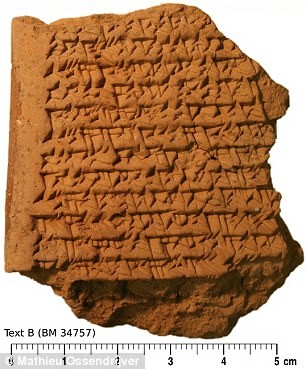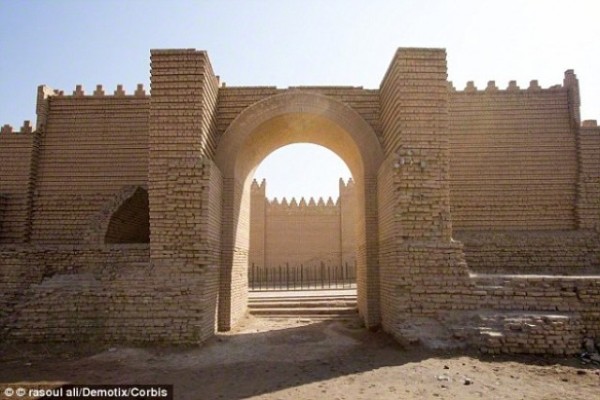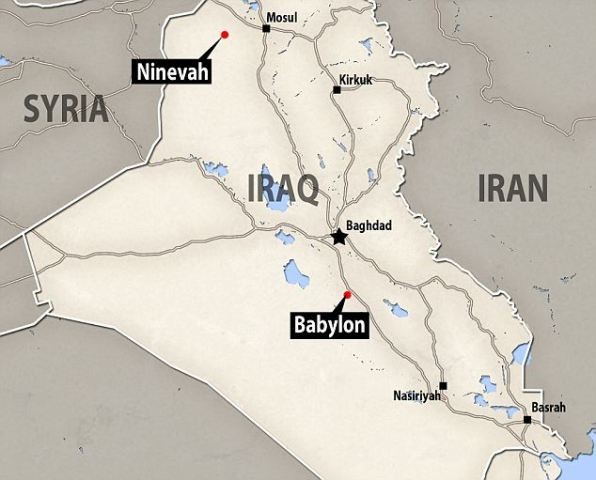
Stone tablets (pictured) used by Babylonians reveal how they tracked the movements of Jupiter
ishtartv.com-
grandjee.com
January
28, 2016
Ancient
Babylonians used geometry to track planets in the solar system more than 1,400
years before Europeans were believed to have devised the mathematical
technique.
The
findings come from analysis of four stone tablets, which reveal how the ancient
civilisation tracked the movements of Jupiter.
Scientists
had believed the mathematical method had been developed by scholars in Europe
in the 14th century, but the tablets date to between 350 to 50 BC.
This
could mean Babylonians were using geometrical methods as much as 1,700 years
earlier.
Professor
Mathieu Ossendrijver, a researcher in the history of ancient science at the
Humboldt-Universität zu Berlin who deciphered the markings, said the tablets
have redefined the history books.
Translation
of the cuneiform tablets revealed they described a mathematical technique to
calculate the positions of large bodies in space and time.
The
markings depict measurements made to track Jupiter as it moved along the
horizon, calculating the planet’s position at 60 days and then at 120 days.
From
this, it appears the Babylonians used geometrical calculations based on a
trapezoid – a four-sided shape in which the top and bottom lines are parallel –
working out the area of the shape, along with its ‘long’ and ‘short’ sides.
The
ancient astronomers also computed the time when Jupiter covered half of the
60-day distance by partitioning the trapezoid into two smaller shapes of equal
area.
What
makes the findings surprising is that it had previously been thought that
Babylonian astronomers only used arithmetical concepts, and not geometry.
While
ancient Greeks used geometrical figures to describe configurations in physical
space, these Babylonian tablets use geometry in an abstract sense to define
time and velocity.

The
markings depict measurements made to track Jupiter as it moved along the
horizon, calculating the planet’s position at 60 days and then at 120 days.
From this, it appears the Babylonians used geometrical calculations based on a
trapezoid (right) working out the area of the shape

The
ancient astronomers also computed the time when Jupiter (pictured) covered half
of the 60-day distance by partitioning the trapezoid into two smaller shapes of
equal area. What makes the findings surprising is that it had previously been
thought that Babylonian astronomers only used arithmetical concepts, and not
geometry
The
discovery of these calculations had historically been credited to scholars in
Europe during the 14th century, at Merton College, Oxford as well as in Paris.
GEOMETRY
AND ASTRONOMY
Analysis
of four stone tablets has revealed that Babylonian astronomers used geometry to
track the movement of Jupiter.
Translation
of the cuneiform tablets revealed they described a mathematical technique to
calculate the positions of large bodies in space and time.
The
markings depict measurements made to track Jupiter as it moved along the
horizon, calculating the planet’s position at 60 days and then at 120
days.
From
this, it appears the Babylonians used geometrical calculations based on a
trapezoid – a four-sided shape in which the top and bottom lines are parallel –
working out the area of the shape, along with its ‘long’ and ‘short’
sides.
When
the measurements were made, Jupiter would have first been seen rising at dawn
and would have been visible for a number of days.
The
astronomers would have then captured the ‘daily displacement’ of the gas giant
as it moved across the sky, measured as degrees per day.
Scientists
had believed that the mathematical method had been developed by scholars in
Europe in the 14th century, but the tablets date to between 350 to 50BC, which
could mean Babylonians were using geometrical methods as much as 1,700 years
earlier.
Professor
Ossendrijver explained: ‘The Babylonian trapezoid procedures can be viewed as a
concrete example of the same computation.
‘They
also show that Babylonian astronomers did, at least occasionally, use
geometrical methods for computing planetary positions.’
The
translations were prompted by a newly discovered tablet, approximately 4cm
across, which shed new light on how the Babylonian astronomers used the
trapezoid method.
When
the measurements were made, Jupiter would have first been seen rising at dawn
and would have been visible for a number of days.
The
astronomers would have then captured the ‘daily displacement’ of the gas giant
as it moved across the sky, measured as degrees per day.
Professor
Ossendrijver wrote: ‘The idea of computing a body’s displacement as an area in
time-velocity space is usually traced back to 14th-century Europe.
‘I
show that in four ancient Babylonian cuneiform tablets, Jupiter’s displacement
along the ecliptic is computed as the area of a trapezoidal figure obtained by
drawing its daily displacement against time.
He
added: ‘The tablets date from 350 to 50 BC.
‘The
trapezoid procedures offer the first evidence for the use of geometrical
methods in Babylonian mathematical astronomy, which was thus far viewed as
operating exclusively with arithmetical concepts.’
Speaking
to MailOnline, Professor Ossendrijve said: ‘The importance of the findings is
that these tablets prove that the Babylonians were using geometry in a way that
anticipates how we describe and compute motion nowadays.
‘That
is, the construct figures that are actually graphs of the velocity (of a
planet) against time, so time on one axis, velocity on the other. This is not
found anywhere else in antiquity.

hen
the measurements were made, Jupiter would have first been seen rising at dawn
and would have been visible for a number of days. The astronomers would have
then captured the ‘daily displacement’ of the gas giant as it moved across the
sky, measured as degrees per day (stone pictured)
‘Any
book on the history of math and physics will tell you this type of graph
(velocity against time) was invented around 1350, in the middle ages. We now
know the Babylonians already invented it.’
A
spokesperson for the British Museum, which supplied the tablets, told MailOnline:
‘We always make our objects freely available to scholars and researchers and
are truly delighted when one of these valiant workers makes an important
breakthrough.
‘It
enlarges our appreciation of what the ancient Babylonian astronomers were capable
of all those centuries ago.’
The
findings are published today in the journal Science.
The
cuneiform stone tablets left behind by the Babylonians, like the ones
translated in this study, provide a wealth of information on ancient
Mesopotamian civilisation.
Last
year an exhibition of ancient
clay tablets discovered in modern-day Iraq shed light on the daily life of Jews
exiled to Babylon 2,500 years ago.

The
cuneiform stone tablets left behind by the Babylonians, like the ones
translated in this study, provide a wealth of information on ancient
Mesopotamian civilisation. This stock image of cuneiform inscriptions from
Babylonia are written in the Sumerian language. They date from the 15th century
More
than 100 cuneiform tablets,
each no bigger than an adult’s palm, detailed transactions
and contracts between Judeans driven from, or convinced to move
from, Jerusalem by King Nebuchadnezzar around 600 BC.
Archaeologists
got their first chance to see the tablets – acquired by a wealthy London-based
Israeli collector – barely two years ago, and said they were ‘blown away’.
Nebuchadnezzar,
a powerful ruler famed for the Hanging
Gardens of Babylon, came to Jerusalem several times as he sought
to spread the reach of his kingdom.
Each
time he came – and one visit coincided with the
destruction of Jerusalem’s first temple in 586 BC – he either
forced or encouraged the exile of thousands of Judeans.
One
exile in 587 BC saw around 1,500 people make the
perilous journey via modern-day Lebanon and Syria to the fertile
crescent of southern Iraq, where the Judeans traded, ran
businesses and helped the administration of the kingdom.
BABYLON
AND ANCIENT MESOPOTAMIA
Mesopotamia
is an ancient Greek term meaning ‘the land between rivers.’
The
region was the name for the Tigris–Euphrates river system, corresponding to
modern-day Iraq, northeastern Syria and southeastern Turkey and smaller parts
of southwestern Iran and Kuwait.
Mesopotamia
has been called the ‘cradle of civilisation’ because agriculture and
domestication developed there earlier than anywhere else, around 8,000 years
ago.
Bronze
Age Mesopotamia included Sumer and the Akkadian, Babylonian, and Assyrian
empires. By 3,000 BC, the Mesopotamians had already invented the wheel,
developed writing, and created the world’s first cities.
Babylon
was a significant city in the region, which was established in 2,300BC.
It
is thought to have been the largest city on the world during its history, and
spawned an advanced civilisation, known for its astronomical observations.
The
city of Babylon was famed for its ‘hanging gardens’ but some have suggested
they were not in Babylon at all but were in a Assyrian city called Ninevah,
which was known as New Babylon.

Gate to Babylon: Babylon was a significant city in Mesopotamia, established in 2,300BC

The hanging gardens of Babylon were believed to have been built in the city because of its name. However, the gardens may have been found in the Assyrian capital of Nineveh, which was known as New Babylon
|